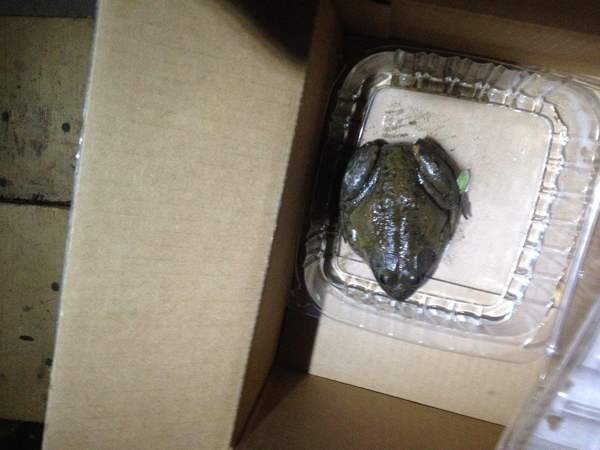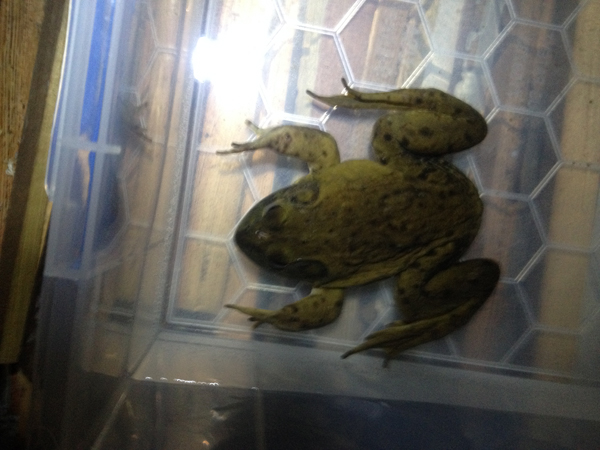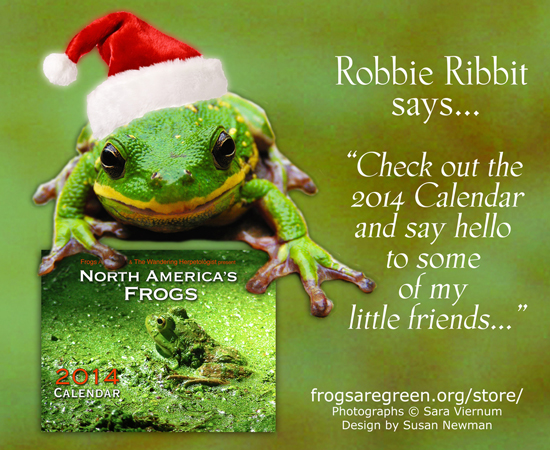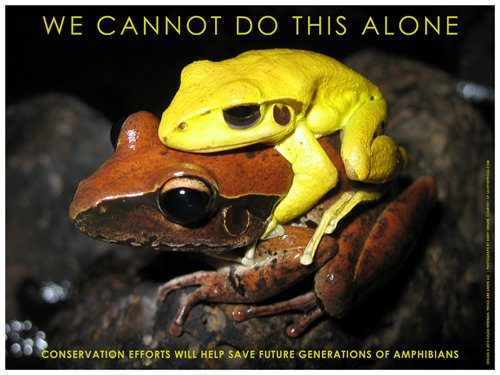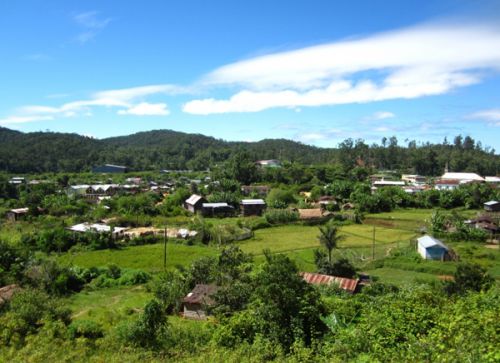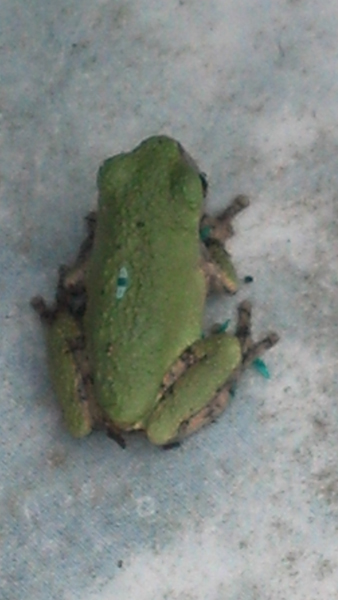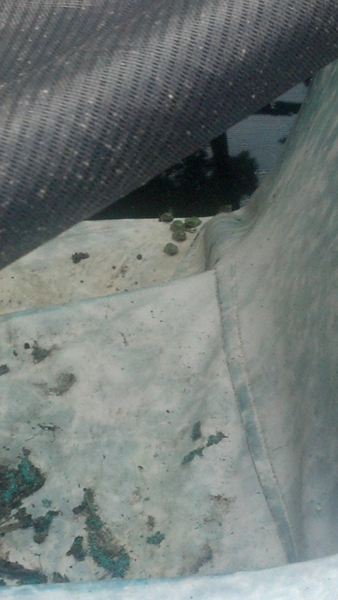Mid-Winter Bullfrog Rescue
I’m so pleased to share a story that comes by way of Lexington, Massachusetts. Jack Stearns, a scientist and Meteorologist, has rescued a bullfrog in the middle of Winter. Below are the details, correspondence that I shared with The Wandering Herpetologist, Sara Viernum, who offers her advice.
Dear Susan,
I hope you can help me with some information.
Where my wife works in eastern MA there is a large garden wall. Yesterday one of her workers came in and told her there was a frog on the sidewalk. My wife went out and there was a huge bullfrog on the sidewalk, sitting half in of snow. By tracing back his path he saw the frog had come out of a huge crack in the wall. We have had brutal weather the last few weeks with temps as low as -10F with heavy snow.
Because the frog would not survive where it was, (i.e a busy sidewalk and a street treated with chemicals) one of my wife’s coworkers placed the frog in a container, using rubber gloves and brought him home. We are frog and toad people so we are very familiar with their needs and habitats, however a frog appearing on your doorstep in the heart of winter is a new one!
The frog is OK and looks in good shape and very plump. He had no signs of any injury, his eyes are clear and he has a moist skin and is very lethargic, which I would expect being in semi-hibernation. I placed him in cold water up to his jaw and put him in our coal cellar which is at a constant 34 degrees since I didn’t want to warm him up to wake him up.
Obviously everything is frozen solid so the only choice I have is to keep him where he is. I looked on him this morning and he definitely is in a hibernation state and you see he is breathing very slowly.
Is there anything else we should be doing until spring arrives? There is a small pond near our house which is full of bullfrogs and eventually we want to place him there. The pond has a small current and I know the frogs burrow into the mud there to escape the current which is stronger in the winter. Right now our frog would be in no state to burrow into the mud.
I hope you can help. This guy is huge and a lovely specimen and we would hate for anything to happen to him.
Thank you, Jack Stearns, Lexington, MA
Jack,
Susan with Frogs Are Green forwarded me your email about the bullfrog. Bullfrogs usually hibernate in the mud in a pond in the wild. Offering your frog wet/moist soil to burrow into might help.
A side note: Bullfrogs are known chytrid fungus carriers. It’s usually not a good idea to relocate any amphibian to another wetland because of the risk of spreading a disease to another population. But I know that allowing an animal to perish instead is not a good option either. I would suggest contacting a local nature center to see if they would be interested in taking the frog.
Thanks for being a friend of amphibians.
Cheers!
Sara E. Viernum
The Wandering Herpetologist
http://www.wanderingherpetologist.com
https://www.facebook.com/thewanderingherpetologist
________________________________________
Sara,
Thank you for response. I will introduce some moist soil into his container. He seems to be doing OK so giving him the soil may increase his chances of survival for the next couple of months.
I did not know about the fungus thus I will not put him in the pond near our house in the Spring. The last thing I want is to start an epidemic in another pond. The frogs in that pond are huge and it is fun to hear them croak in the late Spring and early summer and I don’t want to jeopardize those wonderful sounds.
Where our frog was found by my wife on the sidewalk, is not too far from a small pond near the building where my wife works. It is the only body of water anywhere near the area and had bullfrogs in it. Would it be OK to release him back to that pond since that is where he likely came from?
Another alternative is if I can’t find a local nature center, I have very small manmade pond in my Hostas garden. Maybe he would be happy there in the warm weather, maybe he could control my slug and bug problem.
I will keep you posted on our progress.
My wife and I have always been partial to frogs and toads. Where we spent summers on Chatham, MA the house bordered a pond that was full of Spring peepers in the spring and sounds of Green and Bullfrogs in the summer.
Being a scientist myself (Meteorologist), I am well aware of the environment around me and that we all are stewards of this Planet.
Thanks again, Jack
________________________________________
Jack,
Thanks for considering the impacts of introducing the frog into a new population could cause.
I’d think releasing it in the pond nearest the location it was found would be fine. But he would definitely help control insects in your pond. The only concern would be him surviving in it next winter. The pond would need to have enough debris (leaf litter, mud) and deep enough not to freeze solid for it to hibernate in. Best of luck.
Sara,
________________________________________
Susan and Sara,
Just a note on how Bartholomew is doing. The name comes from a pamphlet printed in 1918 called Bartholomew Bullfrog.
In addition to the assistance I received from you two, I also have been getting help from a gentleman in Rockport, MA who oversees the Vernal Pool program in that town.
Right now the Bullfrog is in a large flat container filled with water with soil on one half of the bottom. Once he was transferred to the tank he took a few strokes then settled to the bottom on the end with no soil where he is definitely in a state of hibernation. He looks good and with a little bit of luck we are all set until Spring. Attached is a picture taken this morning.
He has become quite a celebrity where my wife works since most people there now have heard him being found and are curious on how he is doing.
Thanks again for all your help and I will keep you posted on his progress.
Jack
Update: 1.20.2014
Susan,
Bartholomew continues to do well.
He started to shed is skin so at the suggestion of Sara I moved him into another tank since she said that bacteria could grow in the dead skin and the water could become a little funky.
Moved him in on Saturday. This critter is strong! He is definitely healthy!
Then yesterday he did a sneak out. He managed to lift the corner of the tank top and climb out and went and sat in the corner of the coal room.
I told Sara about the sneak out and she told me that they are notorious escape artists. She also said that he might be happier in a bed of wet soil. I got some wet soil with no additives, fertilizers and the like in it. I put him in that tank and we will see what happens.
With the colder weather moving in, temperatures which now stand at 39F in the coal room will definitely drop to near freezing the next few days and I am sure he will become even less active.
This frog is smart and he knows it!
Sincerely, Jack

